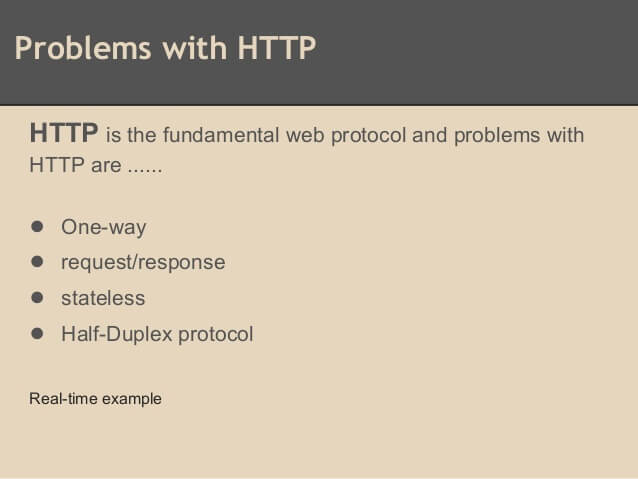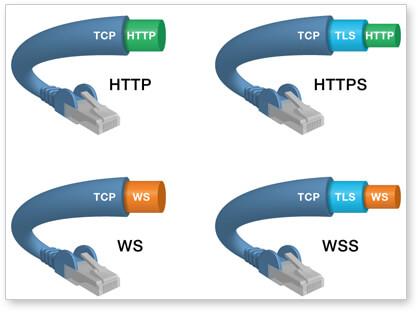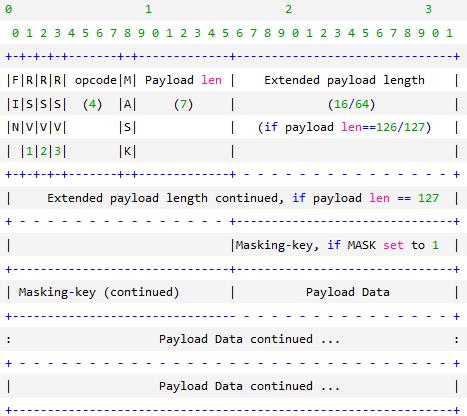websocket的简单使用
Posted 方杰0410
tags:
篇首语:本文由小常识网(cha138.com)小编为大家整理,主要介绍了websocket的简单使用相关的知识,希望对你有一定的参考价值。
一 轮询
什么是轮询:设置每一段时间去访问一次服务器,然后服务器返回最新的数据。这样服务器的压力会非常的大,并且还会有延迟。适用于小型程序。
实现:再客户端的页面设置一个定时发送请求的任务,每个这段时间就要发送一个请求,来获取最新的数据
实例:
app.py

from flask import Flask,render_template app = Flask(__name__) @app.route(\'/index\') def index(): return render_template(\'index.html\') @app.route(\'/message\') def message(): return "信息" if __name__ == \'__main__\': app.run()
index.html

<!DOCTYPE html> <html lang="en"> <head> <meta charset="UTF-8"> <title>Title</title> </head> <body> <h1>投票系统</h1> <script src="{{ url_for(\'static\',filename=\'jquery-3.3.1.min.js\')}}"></script> <script> function getMsg() { $.ajax({ url:\'/message\', success:function (data) { console.log(data) } }) } setInterval(getMsg,2000) </script> </body> </html>
二 长轮询
什么是长轮询:就是客户端发送一次请求,服务端接收到了请求,然后将请求hold住,直到其中某个请求发送数据过来,然后再挨个将最新的数据分享到每一个请求,客户端接收到请求以后,继续发送新的请求。在服务端设置了超时时间,如果超出这段时间,就会断开连接,服务端端口连接以后,客户端又会继续发送新的请求。
实现原理:队列,就是服务端只有一接收到最新的数据,就会将书更新,然后再逐一发送给每一个请求。客户端创建一个对列,将数据通过队列发给了服务端,然后断开队列,然后服务器端在于每一个请求之间创建对列,只要客户端接收到了数据就会断开然后继续发送请求。
实例:
app.py:

from flask import Flask,render_template,request,session,redirect,jsonify import uuid from queue import Queue,Empty app = Flask(__name__) app.secret_key = \'xfsdfqw\' USERS = { \'1\':{\'name\':\'王旭\',\'count\':0}, \'2\':{\'name\':\'放景洪\',\'count\':0}, \'3\':{\'name\':\'六五\',\'count\':0}, } QUEUE_DICT = { } """ { 强哥:queue() 龙哥:queue() } """ @app.before_request def before_request(): if request.path == \'/login\': return None user_info = session.get(\'user_info\') if user_info: return None return redirect(\'/login\') @app.route(\'/login\',methods=[\'GET\',\'POST\']) def login(): if request.method == "GET": return render_template(\'login.html\') else: uid = str(uuid.uuid4()) session[\'user_info\'] = {\'id\':uid,\'name\':request.form.get(\'user\')} QUEUE_DICT[uid] = Queue() return redirect(\'/index\') @app.route(\'/index\') def index(): return render_template(\'index.html\',users=USERS) @app.route(\'/message\') def message(): result = {\'status\':True,\'msg\':None} queue = QUEUE_DICT[session.get(\'user_info\').get(\'id\')] try: v = queue.get(timeout=10) except Empty as e: v = None result[\'msg\'] = v return jsonify(result) @app.route(\'/vote\') def vote(): userid = request.args.get(\'id\') old = USERS[userid][\'count\'] new = old + 1 USERS[userid][\'count\'] = new for k,v in QUEUE_DICT.items(): v.put({\'userid\':userid,\'count\':new}) return \'投票成功\' if __name__ == \'__main__\': app.run(threaded=True)
login.html:

<!DOCTYPE html> <html lang="en"> <head> <meta charset="UTF-8"> <title>Title</title> </head> <body> <form method="post"> <input type="text" name="user"> <input type="submit" value="提交"> </form> </body> </html>
index.html:

<!DOCTYPE html> <html lang="en"> <head> <meta charset="UTF-8"> <title>Title</title> </head> <body> <h1>投票系统</h1> <ul> {% for k,v in users.items() %} <li id="user_{{k}}" ondblclick="vote(\'{{k}}\')">{{v.name}} <span>{{v.count}}</span> </li> {% endfor %} </ul> <script src="{{ url_for(\'static\',filename=\'jquery-3.3.1.min.js\')}}"></script> <script> $(function () { getMsg(); }); function getMsg() { $.ajax({ url:\'/message\', success:function (data) { if(data.msg){ var nid = "#user_"+data.msg.userid; $(nid).find(\'span\').text(data.msg.count); } getMsg(); } }) } function vote(id) { $.ajax({ url:\'/vote\', data:{\'id\':id}, success:function (data) { console.log(\'投票成功\'); } }) } </script> </body> </html>
三 websocket
为什么要有websocket
初次接触 WebSocket 的人,都会问同样的问题:我们已经有了 HTTP 协议,为什么还需要另一个协议?它能带来什么好处?
答案很简单,因为 HTTP 协议有一个缺陷:通信只能由客户端发起。
举例来说,我们想了解今天的天气,只能是客户端向服务器发出请求,服务器返回查询结果。HTTP 协议做不到服务器主动向客户端推送信息。

这种单向请求的特点,注定了如果服务器有连续的状态变化,客户端要获知就非常麻烦。我们只能使用"轮询":每隔一段时候,就发出一个询问,了解服务器有没有新的信息。最典型的场景就是聊天室。
轮询的效率低,非常浪费资源(因为必须不停连接,或者 HTTP 连接始终打开)。因此,工程师们一直在思考,有没有更好的方法。WebSocket 就是这样发明的。
websocket的介绍:
服务器可以主动向客户端推送信息,客户端也可以主动向服务器发送信息,是真正的双向平等对话,属于服务器推送技术的一种。
建立的socket创建TCP之上:与 HTTP 协议有着良好的兼容性。默认端口也是80和443,并且握手阶段采用 HTTP 协议,因此握手时不容易屏蔽,能通过各种 HTTP 代理服务器。
数据格式比较轻量,性能开销小,通信高效
可以发送文本,也可以发送二进制数据。
没有同源限制,客户端可以与任意服务器通信
协议标识符是ws(如果加密,则为wss),服务器网址就是 URL。
HTTP协议:http://www.xxx.com 请求+响应+断开 一次请求一次响应
WebSocket:ws://example.com:80/some/path
1. 浏览器:发送请求“随机字符串”
2. 服务端:加密,再返还
3. 浏览器:检测加密后的结果是否是正确的
4. 正确:建立连接【再也不断开】

详细信息:http://www.ruanyifeng.com/blog/2017/05/websocket.html
websocket的本质:
浏览器:发送链接
服务器:接受链接
浏览器:发送握手信息Sec-WebSocket-Key: dCp5MdkY90EIJ83Qdddpjw==\\r\\n
服务器:base64(sha1(dCp5MdkY90EIJ83Qdddpjw== + magic string))
浏览器:接收值,并在内部进行校验
校验成功:on_open
校验失败:验证失败
相互之间进行收发消息:
浏览器发送消息到服务器:

1. 获取第二个字节的,前7位 2. 7位 <= 125;+0;mask_key=4;数据 7位 == 126;+2;mask_key=4;数据 7位 == 127;+8;mask_key=4;数据 3. mask_key=4;数据
服务器向浏览器推送消息:1. 数据头+数据

0 1 2 3
0 1 2 3 4 5 6 7 8 9 0 1 2 3 4 5 6 7 8 9 0 1 2 3 4 5 6 7 8 9 0 1
+-+-+-+-+-------+-+-------------+-------------------------------+
|F|R|R|R| opcode|M| Payload len | Extended payload length |
|I|S|S|S| (4) |A| (7) | (16/64) |
|N|V|V|V| |S| | (if payload len==126/127) |
| |1|2|3| |K| | |
+-+-+-+-+-------+-+-------------+ - - - - - - - - - - - - - - - +
| Extended payload length continued, if payload len == 127 |
+ - - - - - - - - - - - - - - - +-------------------------------+
| |Masking-key, if MASK set to 1 |
+-------------------------------+-------------------------------+
| Masking-key (continued) | Payload Data |
+-------------------------------- - - - - - - - - - - - - - - - +
: Payload Data continued ... :
+ - - - - - - - - - - - - - - - - - - - - - - - - - - - - - - - +
| Payload Data continued ... |
+---------------------------------------------------------------+
请求过程解析:
启动服务器:启动Socket服务器过后,等待着用户的链接,然后进行数据的收发

import socket sock = socket.socket(socket.AF_INET, socket.SOCK_STREAM) sock.setsockopt(socket.SOL_SOCKET, socket.SO_REUSEADDR, 1) sock.bind((\'127.0.0.1\', 8002)) sock.listen(5) # 等待用户连接 conn, address = sock.accept() ... ... ...
客户端连接:当客户端向服务器发送连接的请求的时候,不仅发送连接请求,还会发送握手的信息,并等待服务器的响应,至此链接才会创建成功

<script type="text/javascript"> var socket = new WebSocket("ws://127.0.0.1:8002/xxoo"); ... </script>
建立握手:

import socket sock = socket.socket(socket.AF_INET, socket.SOCK_STREAM) sock.setsockopt(socket.SOL_SOCKET, socket.SO_REUSEADDR, 1) sock.bind((\'127.0.0.1\', 8002)) sock.listen(5) # 获取客户端socket对象 conn, address = sock.accept() # 获取客户端的【握手】信息 data = conn.recv(1024) ... ... ... conn.send(\'响应【握手】信息\')
请求和响应的【握手】信息需要遵循规则:
从请求【握手】信息中提取 Sec-WebSocket-Key
利用magic_string 和 Sec-WebSocket-Key 进行hmac1加密,再进行base64加密
将加密结果响应给客户端
请求握手的信息为:

GET /chatsocket HTTP/1.1 Host: 127.0.0.1:8002 Connection: Upgrade Pragma: no-cache Cache-Control: no-cache Upgrade: websocket Origin: http://localhost:63342 Sec-WebSocket-Version: 13 Sec-WebSocket-Key: mnwFxiOlctXFN/DeMt1Amg== Sec-WebSocket-Extensions: permessage-deflate; client_max_window_bits ... ...
提取Sec-WebSocket-Key的值并且加密:

import socket import base64 import hashlib def get_headers(data): """ 将请求头格式化成字典 :param data: :return: """ header_dict = {} data = str(data, encoding=\'utf-8\') for i in data.split(\'\\r\\n\'): print(i) header, body = data.split(\'\\r\\n\\r\\n\', 1) header_list = header.split(\'\\r\\n\') for i in range(0, len(header_list)): if i == 0: if len(header_list[i].split(\' \')) == 3: header_dict[\'method\'], header_dict[\'url\'], header_dict[\'protocol\'] = header_list[i].split(\' \') else: k, v = header_list[i].split(\':\', 1) header_dict[k] = v.strip() return header_dict sock = socket.socket(socket.AF_INET, socket.SOCK_STREAM) sock.setsockopt(socket.SOL_SOCKET, socket.SO_REUSEADDR, 1) sock.bind((\'127.0.0.1\', 8002)) sock.listen(5) conn, address = sock.accept() data = conn.recv(1024) headers = get_headers(data) # 提取请求头信息 # 对请求头中的sec-websocket-key进行加密 response_tpl = "HTTP/1.1 101 Switching Protocols\\r\\n" \\ "Upgrade:websocket\\r\\n" \\ "Connection: Upgrade\\r\\n" \\ "Sec-WebSocket-Accept: %s\\r\\n" \\ "WebSocket-Location: ws://%s%s\\r\\n\\r\\n" magic_string = \'258EAFA5-E914-47DA-95CA-C5AB0DC85B11\' value = headers[\'Sec-WebSocket-Key\'] + magic_string ac = base64.b64encode(hashlib.sha1(value.encode(\'utf-8\')).digest()) response_str = response_tpl % (ac.decode(\'utf-8\'), headers[\'Host\'], headers[\'url\']) # 响应【握手】信息 conn.send(bytes(response_str, encoding=\'utf-8\')) ... ... ...
客户端和服务端进行收发数据:收发数据时需要封包和解包,客户端的javascript类的库已经封装好了封包和解包的过程,但是socket服务器需要手动实现
获取客户端发送的数据进行解包:

info = conn.recv(8096) payload_len = info[1] & 127 if payload_len == 126: extend_payload_len = info[2:4] mask = info[4:8] decoded = info[8:] elif payload_len == 127: extend_payload_len = info[2:10] mask = info[10:14] decoded = info[14:] else: extend_payload_len = None mask = info[2:6] decoded = info[6:] bytes_list = bytearray() for i in range(len(decoded)): chunk = decoded[i] ^ mask[i % 4] bytes_list.append(chunk) body = str(bytes_list, encoding=\'utf-8\') print(body)
解包的过程:


The MASK bit simply tells whether the message is encoded. Messages from the client must be masked, so your server should expect this to be 1. (In fact, section 5.1 of the spec says that your server must disconnect from a client if that client sends an unmasked message.) When sending a frame back to the client, do not mask it and do not set the mask bit. We\'ll explain masking later. Note: You have to mask messages even when using a secure socket.RSV1-3 can be ignored, they are for extensions. The opcode field defines how to interpret the payload data: 0x0 for continuation, 0x1 for text (which is always encoded in UTF-8), 0x2 for binary, and other so-called "control codes" that will be discussed later. In this version of WebSockets, 0x3 to 0x7 and 0xB to 0xF have no meaning. The FIN bit tells whether this is the last message in a series. If it\'s 0, then the server will keep listening for more parts of the message; otherwise, the server should consider the message delivered. More on this later. Decoding Payload Length To read the payload data, you must know when to stop reading. That\'s why the payload length is important to know. Unfortunately, this is somewhat complicated. To read it, follow these steps: Read bits 9-15 (inclusive) and interpret that as an unsigned integer. If it\'s 125 or less, then that\'s the length; you\'re done. If it\'s 126, go to step 2. If it\'s 127, go to step 3. Read the next 16 bits and interpret those as an unsigned integer. You\'re done. Read the next 64 bits and interpret those as an unsigned integer (The most significant bit MUST be 0). You\'re done. Reading and Unmasking the Data If the MASK bit was set (and it should be, for client-to-server messages), read the next 4 octets (32 bits); this is the masking key. Once the payload length and masking key is decoded, you can go ahead and read that number of bytes from the socket. Let\'s call the data ENCODED, and the key MASK. To get DECODED, loop through the octets (bytes a.k.a. characters for text data) of ENCODED and XOR the octet with the (i modulo 4)th octet of MASK. In pseudo-code (that happens to be valid JavaScript): var DECODED = ""; for (var i = 0; i < ENCODED.length; i++) { DECODED[i] = ENCODED[i] ^ MASK[i % 4]; } Now you can figure out what DECODED means depending on your application.
向客户端发送数据进行封包:

def send_msg(conn, msg_bytes): """ WebSocket服务端向客户端发送消息 :param conn: 客户端连接到服务器端的socket对象,即: conn,address = socket.accept() :param msg_bytes: 向客户端发送的字节 :return: """ import struct token = b"\\x81" length = len(msg_bytes) if length < 126: token += struct.pack("B", length) elif length <= 0xFFFF: token += struct.pack("!BH", 126, length) else: token += struct.pack("!BQ", 127, length) msg = token + msg_bytes conn.send(msg) return True
实例1:websocket本质
s1.py:

import socket import base64 import hashlib
